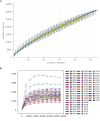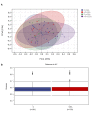Analysis of Salivary Microbiome and Its Association With Periodontitis in Patients With Obstructive Sleep Apnea
- PMID: 34950605
- PMCID: PMC8688821
- DOI: 10.3389/fcimb.2021.752475
Analysis of Salivary Microbiome and Its Association With Periodontitis in Patients With Obstructive Sleep Apnea
Abstract
Objectives: This study aimed to analyze the periodontal conditions of patients with obstructive sleep apnea (OSA) in relation to the salivary microbiome.
Materials and methods: In total, 54 male adults (27 with OSA, 27 controls) completed this cross-sectional study. All participants were monitored by overnight polysomnography (PSG) and underwent full-mouth periodontal examination. Saliva samples were then collected, and the microbial 16S ribosomal RNA gene was sequenced. The data were analyzed to determine the microbial distribution and the community structure of the two groups.
Results: Demonstrated by alpha and beta diversity, the OSA group had a lower microbial richness and a lower observed species than the controls. There was no significant difference in the microbial species diversity or evenness between the OSA and the non-OSA groups. The OSA group had fewer operational taxonomic units (OTUs), and the distribution of microbiome showed that several gram-positive bacteria had higher abundance in the OSA group. As for periodontal pathogens, the relative abundance of Prevotella was significantly increased in the OSA group. No significant difference was observed in the relative abundance of other pathogens at either the genus or species level.
Conclusions: The salivary microbial community structure was altered in patients with OSA in terms of species richness and trans-habitat diversity, along with an increase in Prevotella, a specific periodontal pathogen. These findings might explain the high prevalence of periodontitis in OSA patients.
Keywords: 16S rRNA gene sequencing; obstructive sleep apnea; periodontal pathogens; periodontitis; salivary microbiome.
Copyright © 2021 Chen, Chen, Huang, Duan, Gao and Gao.
Conflict of interest statement
The authors declare that the research was conducted in the absence of any commercial or financial relationships that could be construed as a potential conflict of interest.
Figures





References
-
- Al-Jewair T., Apessos I., Stellrecht E., Koch R., Almaghrabi B. (2020). An Update on the Association Between Periodontitis and Obstructive Sleep Apnea. Curr. Oral. Health Rep. 7, 189–201. doi: 10.1007/s40496-020-00271-5 - DOI
Publication types
MeSH terms
LinkOut - more resources
Full Text Sources
Research Materials

